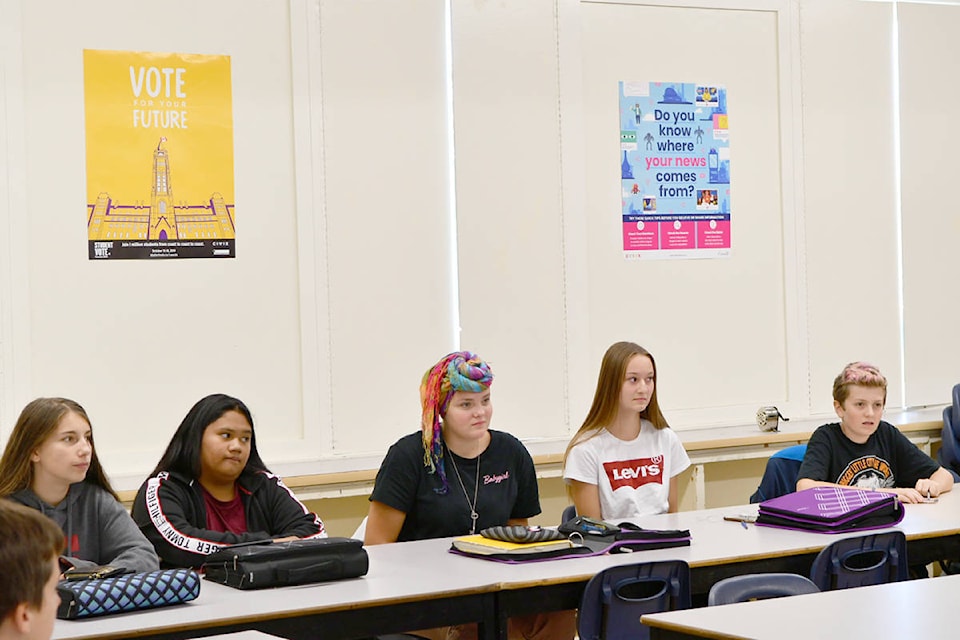Some students at Lake Trail Middle School got the chance recently to pose a question to the leaders of the federal parties.
Teacher Tim Horner’s class of Grade 8/9 students was one of a handful chosen across the country to record a question via video to which each of the leaders were asked to respond.
“Our class got chosen as one of six,” he says.
Horner and several other teachers across the district also took part in a recent democracy “boot camp” for teachers in B.C. on how to engage students in a discussion about the election as part of the Student Vote initiative.
In June, his class made the video to email the question as part of the Student Vote social studies unit. They found out in July their submission was one of the six chosen, and then in September, the video questions were sent to the party leaders.
READ MORE: Takin’ it to the streets
One student, Khate Abat, moved here from the Philippines three years ago, says this process acts a good introduction to politics in Canada.
“It can really help me in the future,” she says.
In general, students in School District 71 have been more engaged than most students in Canada. Local students’ engagement and registration levels have been in the top 10 per cent across the country. Students will continue to engage in discussion around topics such as first impressions, rights and responsibilities, media literacy or the parties and party platforms before they get a chance to go to the polls on Oct. 17. They will even be casting votes in Elections Canada ballot boxes.
“It culminates with a Student Vote day,” Horner says. ‘The idea is to get them talking.”
The hope is that this process gets students communicating with their families about issues important to them as young people, so they can make up their own minds once they are eligible to vote.
“It’s important that we get our own point of view,” says student Logan O’Brien.
The ballots will be tallied to see how the vote compares with actual voting results from the Oct. 21 election.
Back in Horner’s class, the experience with the video has helped bring the students who were in Grade 8 last year and Grade 9 this year a little closer to the process.
“That little piece went so far,” Horner says.
Some had the chance to take part in a similar process in earlier grades, like Madyson Waterfield, who went through Student Vote in Grade 5.
“It’s really important for us to learn about this so that when we do have the opportunity to vote, that we know what we’re doing and what the different parties are,” she says.
Constance Clugston had taken a unit in Grade 6, saying her class leaned toward one party.
“Most of my class decided they would vote for the Green Party because they thought they were the most engaged with us as students,” she says.
The students feel a little more in touch this time around and are paying attention to the messages they’re hearing and seeing from party leaders.
“It’s all about the first impressions,” says Alex Robertson. “I found a lot of them, they kind of sound like robots.”
The process has them discussing everything, like how the leaders answered the question, or whether they did. They are noticing things like how the leaders shoot their video responses and what kinds of images and message the leaders want to get across their message. They are becoming conscious of demographic issues such as ethnicity or gender and what this might mean to the electoral process, or even which party another party sees as the biggest target. Lexi Greeley says a lot of them ignored the question the students asked or made their way around it.
“They didn’t, like, specifically answer it, they didn’t even come out and say our question,” she says. “They also kept going after each other. There’s two parties that specifically went after each other.”
For many current Grade 8 students in the class, the experience is new, compared with their Grade 9 counterparts, and if they seem a little more hesitant about jumping into a discussion with a visiting newspaper reporter about the project, the Student Vote initiative still has got them noticing a few things too.
“I think most of them didn’t really answer our question completely,” says Ella Blancard.
mike.chouinard@comoxvalleyrecord.com
Like us on Facebook and follow us on Twitter.
